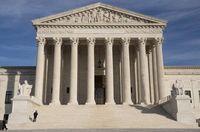The Supreme Court of the United States is once again at the center of the nation’s most contentious legal and political battles, as a flurry of high-profile cases and urgent applications dominate its fall term. With President Donald Trump’s second term well underway, the Court’s docket has grown increasingly complex, reflecting the broader ideological shifts and tensions shaping American governance in 2025.
On October 24, 2025, the ELB Podcast’s Season 7, Episode 2 featured an in-depth conversation with Michigan law professor Leah Litman, who discussed the Supreme Court’s pronounced rightward shift in areas such as voting rights and campaign finance. Litman, author of the new book “Lawless,” offered insights into how the Court’s so-called “shadow docket”—a term used to describe emergency orders and summary decisions issued without full briefing or oral argument—has affected both the Court’s public image and its relationship with President Trump. According to the ELB Podcast, the discussion also tackled how the justices approach their most controversial cases, a topic that feels more relevant than ever as the Supreme Court’s decisions increasingly reverberate across the nation’s legal and political landscapes.
Meanwhile, on October 23, the Supreme Court agreed to extend the oral argument times for a pair of pivotal cases challenging the legality of President Trump’s tariffs. These cases, scheduled for November 5, focus on the president’s authority under the International Emergency Economic Powers Act (IEEPA) and the Trade Act of 1974 to impose sweeping tariffs during national emergencies. As Newsweek reported, the Court’s decision to expand the allotted argument time—granting 40 minutes to the solicitor general and 20 minutes each to advocates for private and state parties—underscored the significance of the dispute. The justices’ move also reflected the urgent pleas from small businesses and states that argue Trump’s invocation of emergency powers has pushed them to the brink of economic collapse.
Lower courts have repeatedly ruled against the Trump administration’s broad use of emergency authority for tariff policy, but the Supreme Court has shown a willingness to grant the president considerable latitude since his return to office. Alan Wm. Wolff, former deputy director-general of the World Trade Organization, told Newsweek that the current trajectory suggests the administration may ultimately prevail: “I think the administration will ultimately get a victory.”
President Trump himself weighed in on Truth Social in August, defending his tariff strategy and criticizing judicial opposition: “Without Tariffs, and all of the TRILLIONS OF DOLLARS we have already taken in, our Country would be completely destroyed, and our military power would be instantly obliterated. In a 7 to 4 Opinion, a Radical Left group of judges didn’t care, but one Democrat, Obama appointed, actually voted to save our Country. I would like to thank him for his Courage! He loves and respects the U.S.A.”
Attorneys representing plaintiffs in the Supreme Court cases have voiced concerns about the broader implications of unchecked executive power. Jeffrey Schwab, who represents one of the parties challenging the tariffs, told Newsweek: “The concern is that if we allow it here that could creep into other laws that give the executive branch greater power.” The White House, for its part, maintains that President Trump has acted within the law. Spokesman Kush Desai emphasized: “The fact of the matter is that President Trump has acted lawfully by using the tariff powers granted to him by Congress in IEEPA to deal with national emergencies and to safeguard our national security and economy. We look forward to ultimate victory on this matter with the Supreme Court.”
Beyond the high-profile tariff disputes, the Supreme Court’s so-called “interim” or “shadow” docket remains unusually active. According to SCOTUSblog, the justices are currently weighing several urgent applications, many of which stem from the Trump administration’s aggressive use of executive authority. Among the most closely watched is Trump v. Illinois, in which the administration seeks to deploy the National Guard to Illinois. U.S. Solicitor General D. John Sauer argued that blocking the deployment “cause[s] irreparable harm to the Executive Branch by countermanding the President’s authority as Commander in Chief, jeopardizing the lives and safety of DHS officers, and preventing the President and the Secretary of War from taking reasonable and lawful measures to protect federal personnel from the violent resistance that has persisted in the Chicago area for several months.”
U.S. District Judge April Perry, who issued the original order blocking the deployment, countered that “resort to the military to execute the laws” was not currently justified. While acknowledging incidents of vandalism and assaults on federal agents, she maintained that the administration had not presented enough evidence to warrant such drastic action. The order, initially set to expire on October 23, was extended until a final judgment could be reached, signaling that the legal battle is far from over.
Another significant case on the interim docket is Trump v. Orr, which concerns the administration’s attempt to change federal policy on sex markers for passports. The Biden administration’s approach allowed applicants to select their sex designation without medical paperwork, but the Trump administration is seeking to revert to a policy based on “immutable biological classification as either male or female.” Plaintiffs argue that the new rules violate their constitutional rights and international travel freedoms. The case has been fully briefed for weeks, and a decision could come at any moment.
Family law and international custody disputes have also reached the Supreme Court’s shadow docket. In Castro v. Guevara, the justices are considering whether a 7-year-old girl living in Dallas should be forced to return to Venezuela under the Hague Convention on International Child Abduction. Justice Samuel Alito granted an administrative stay to keep the child in the United States while the Court reviews the case, highlighting the human stakes at play in these interim decisions.
Perhaps the most consequential of the pending cases is Trump v. Cook, which addresses the president’s power to remove the heads of independent federal agencies. President Trump’s attempt to fire Federal Reserve Governor Lisa Cook, citing alleged mortgage fraud (allegations Cook denies), has prompted a major legal showdown. U.S. District Judge Jia Cobb and the D.C. Circuit Court both ruled in Cook’s favor, emphasizing her due process rights and the independence of the Federal Reserve. The Supreme Court has scheduled oral arguments for January 2026, ensuring that the issue will remain in the public eye well into the new year.
All of this activity comes as the Supreme Court’s methods and motivations face increasing scrutiny. As Leah Litman noted on the ELB Podcast, the Court’s rightward drift and its growing reliance on the shadow docket raise profound questions about transparency, accountability, and the future of American democracy. With major decisions looming on tariffs, executive power, and civil rights, the justices’ actions over the next few months will shape the nation’s legal and political trajectory in ways both immediate and lasting.
The Supreme Court’s docket, both public and shadow, remains a battleground for the nation’s most urgent and divisive issues, ensuring that its influence will be felt in every corner of American life as 2025 draws to a close.





